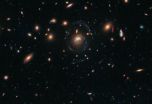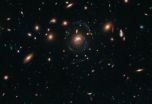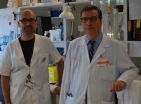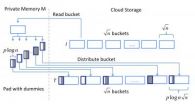(Press-News.org) The Universe is filled with objects springing to life, evolving and dying explosive deaths. This new image from the NASA/ESA Hubble Space Telescope captures a snapshot of some of this cosmic movement. Embedded within the egg-shaped blue ring at the centre of the frame are two galaxies. These galaxies have been found to be merging into one and a "chain" of young stellar superclusters are seen winding around the galaxies' nuclei.
At the centre of this image lie two elliptical galaxies, part of a galaxy cluster known as[HGO2008]SDSS J1531+3414, which have strayed into each other's paths. While this region has been observed before, this new Hubble picture shows clearly for the first time that the pair are two separate objects. However, they will not be able to hold on to their separate identities much longer, as they are in the process of merging into one [1].
Finding two elliptical galaxies merging is rare, but it is even rarer to find a merger between ellipticals rich enough in gas to induce star formation. Galaxies in clusters are generally thought to have been deprived of their gaseous contents; a process that Hubble has recently seen in action. Yet, in this image, not only have two elliptical galaxies been caught merging but their newborn stellar population is also a rare breed.
The stellar infants -- thought to be a result of the merger -- are part of what is known as "beads on a string" star formation. This type of formation appears as a knotted rope of gaseous filaments with bright patches of new stars and the process stems from the same fundamental physics which causes rain to fall in droplets, rather than as a continuous column [2].
Nineteen compact clumps of young stars make up the length of this "string", woven together with narrow filaments of hydrogen gas. The star formation spans 100,000 light years, which is about the size of our galaxy, the Milky Way. The strand is dwarfed, however, by the ancient, giant merging galaxies that it inhabits. They are about 330,000 light years across, nearly three times larger than our own galaxy. This is typical for galaxies at the centre of massive clusters, as they tend to be the largest galaxies in the Universe.
The electric blue arcs making up the spectacular egg-like shape framing these objects are a result of the galaxy cluster's immense gravity. The gravity warps the space around it and creates bizarre patterns using light from more distant galaxies.
Astronomers have ruled out the possibility that the blue strand is also just a lensed mirage from distant galaxies and now their challenge is to understand the origin of the cold gas that is fuelling the growth of the stellar superclusters. Was the gas already in the merging galaxies? Did it condense like rain from the rapidly cooling X-ray plasma surrounding the two galaxies? Or, did it cool out of a shock in the X-ray gas as the ten-million-degree gaseous halos surrounding the galaxies collided together? Future observations with both space- and ground-based observatories are needed to unravel this mystery.
INFORMATION:
Notes
[1] Mergers occur when two or more galaxies stray too close to one another, causing them to coalesce into one large body (heic0912). The violent process strips gas, dust and stars away from the galaxies involved and can alter their appearances dramatically, forming large gaseous tails, glowing rings, and warped galactic discs (heic0810).
[2] The merging system is forming stellar superclusters in equally spaced beads just like evenly spaced drops from a tap. The only real difference is that surface tension in the falling water is analogous to gravity in the context of the star-forming chain. This is a wonderful demonstration that the fundamental laws of physics really are scale-invariant - we see the same physics in rain drops that we do on 100 000 light-year scales.
More information
The Hubble Space Telescope is a project of international cooperation between ESA and NASA.
Image credit: NASA, ESA/Hubble and G. Tremblay (European Southern Observatory)
Acknowledgement: M. Gladders & M. Florian (University of Chicago, USA), S. Baum, C. O'Dea & K. Cooke (Rochester Institute of Technology, USA), M. Bayliss (Harvard-Smithsonian Center for Astrophysics, USA), H. Dahle (University of Oslo, Norway), T. Davis (European Southern Observatory), J. Rigby (NASA Goddard Space Flight Center, USA), K. Sharon (University of Michigan, USA), E. Soto (The Catholic University of America, USA) and E. Wuyts (Max-Planck-Institute for Extraterrestrial Physics, Germany).
Links
NASA release
Contacts
Georgia Bladon
ESA/Hubble, Public Information Officer
Garching bei München, Germany
Tel: +44 7816 291 261
Email: gbladon@partner.eso.org
Merging galaxies and droplets of starbirth
Hubble snaps a violent galactic merger and chain of star formation
2014-07-10
ELSE PRESS RELEASES FROM THIS DATE:
Diving for pearls with the Hubble Space Telescope
2014-07-10
Stars forming like a string of blue pearls along two elliptical galaxies could be the result of a galactic merger, according to an international team of astronomers. The structure could reveal rare insights about elliptical galaxies.
Scientists from Rochester Institute of Technology helped analyze data from the Hubble Space Telescope showing elliptical galaxies coalescing at the core of a dense galaxy cluster. The study is part of a program sponsored by the Hubble Space Telescope—an international cooperation between NASA and the European Space Agency—to look inside 23 ...
Want a higher GPA in college? Join a gym
2014-07-10
EAST LANSING, Mich. – For those students looking to bump up their grade point averages during college, the answer may not be spending more time in a library or study hall, but in a gym.
New Michigan State University research shows that students who were members of the recreational sports and fitness centers on MSU's campus during their freshman and sophomore years had higher GPAs than those who weren't.
The research also indicated that students with memberships stayed in school longer. An increase of 3.5 percent in two-year retention rates was seen among this group.
"That ...
Feedback control could be key to robust conservation management
2014-07-10
Mathematical algorithms used to control everyday household items such as washing machines could hold the key to winning the fight for conservation, a new study has claimed.
As part of an EPSRC research project, a team of UK scientists and mathematicians, including those from the University of Exeter, have shown how techniques commonly used in control engineering, could be replicated in the natural world to help restock declining populations.
The innovative new study suggests 'integral control' - in essence a built-in feedback control mechanism to maintain a constant – ...
Wildfires dot central Russia's landscape
2014-07-10
This natural-color satellite image was collected by the Moderate Resolution Imaging Spectroradiometer (MODIS) aboard the Aqua satellite on July 10, 2014. Each hot spot, which appears as a red mark, is an area where the thermal detectors on the MODIS instrument recognized temperatures higher than background. When accompanied by plumes of smoke, as in this image, such hot spots are diagnostic for fire.
This area of Russia is extremely remote with little danger coming directly from the fires, although the smoke released by any type of fire (forest, brush, crop, structure, ...
Ferromagnetism at 230 K found in a new diluted magnetic semiconductor by Chinese physicists
2014-07-10
Diluted magnetic semiconductors (DMS) have received much attention due to their potential application in spintronics, or the storage and transfer of information by using an electron's spin state, its magnetic moment and its charge.
In typical systems based on III-V semiconductors, such as (Ga,Mn)As, (In,Mn)As or (Ga,Mn)N, substitution of divalent Mn atoms into trivalent Ga (or In) sites leads to severely limited chemical solubility, resulting in metastable specimens only available as epitaxial thin films. The hetero-valence substitution, which simultaneously dopes both ...
Scientists discover clues why weight-loss surgery cures diabetes
2014-07-10
Scientists at The University of Manchester are a step closer to understanding why diabetes is cured in the majority of patients that undergo gastric bypass surgery.
The research, published in the journal Endocrinology, shows the cure is likely to be explained by the actions of specialised cells in the intestine that secrete a cocktail of powerful hormones when we eat.
During the research, the team showed that gut hormone cells previously thought to contain just one hormone, had up to six hormones including the hunger hormone ghrelin.
Study team leader, Dr Craig ...
Straits of Mackinac 'worst possible place' for a Great Lakes oil spill
2014-07-10
ANN ARBOR – Because the strong currents in the Straits of Mackinac reverse direction every few days, a rupture of the oil pipeline beneath the channel would quickly contaminate shorelines miles away in both lakes Michigan and Huron, according to a new University of Michigan study commissioned by the National Wildlife Federation.
In one scenario examined in the study and accompanying animations, oil from a hypothetical pipeline break reached Mackinac Island and Round Island after 12 hours and Bois Blanc Island after two days. All three islands are in westernmost Lake Huron, ...
New drug active against most aggressive type of lung cancer cells
2014-07-10
Manchester scientists have shown that a new drug could prove useful in treating small cell lung cancer - the most aggressive form of lung cancer.
Scientists from the Cancer Research UK Manchester Institute, based at The University of Manchester and part of the Manchester Cancer Research Centre, teamed up with experts at AstraZeneca, as part of a collaboration agreed in 2010, to test a drug – known as AZD3965 - on small cell lung cancer cells.
The research, published in the journal Clinical Cancer Research, also helps identify which patients are most likely to respond ...
New therapeutic combination to slow resistant sarcomas
2014-07-10
Researchers at sarcomas research group at the Bellvitge Biomedical Research Institute (IDIBELL) and the Catalan Institute of Oncology (ICO) have been tested in 19 patients a new therapeutic combination to combat resistant sarcomas. The clinical trial results, which indicate that the new treatment could stabilize the growth of these tumors have been published this week in the British Journal of Cancer.
Sarcomas
Sarcomas are a rare type of tumor and complex since there are several subtypes. It can affect from children to older ages. It is usually diagnosed in advanced and ...
'Melbourne Shuffle' secures data in the cloud
2014-07-10
PROVIDENCE, R.I. [Brown University] — To keep data safe in the cloud, a group of computer scientists suggests doing the Melbourne Shuffle.
That may sound like a dance move (and it is), but it's also a computer algorithm developed by researchers at Brown University.
The computing version of the Melbourne Shuffle aims to hide patterns that may emerge as users access data on cloud servers. Patterns of access could provide important information about a dataset — information that users don't necessarily want others to know — even if the data files themselves are encrypted.
"Encrypting ...
LAST 30 PRESS RELEASES:
Norbert Holtkamp appointed director of Fermi National Accelerator Laboratory
New agentic AI platform accelerates advanced optics design
Biologists discover neurons use physical signals — not electricity — to stabilize communication
Researchers discover that a hormone can access the brain by hitchhiking
University of Oklahoma researcher awarded funding to pursue AI-powered material design
Exploring how the visual system recovers following injury
Support for parents with infants at pediatric check-ups leads to better reading and math skills in elementary school
Kids’ behavioral health is a growing share of family health costs
Day & night: Cancer disrupts the brain’s natural rhythm
COVID-19 vaccination significantly reduces risk to pregnant women and baby
The role of vaccination in maternal and perinatal outcomes associated with COVID-19 in pregnancy
Mayo Clinic smartwatch system helps parents shorten and defuse children's severe tantrums early
Behavioral health spending spikes to 40% of all children’s health expenditures, nearly doubling in a decade
Digital cognitive behavioral treatment for generalized anxiety disorder
Expenditures for pediatric behavioral health care over time and estimated family financial burden
Air conditioning in nursing homes and mortality during extreme heat
The Alps to lose a record number of glaciers in the next decade
What makes a good proton conductor?
New science reporting guide published for journalists in Bulgaria
New international study reveals major survival gaps among children with cancer
New science reporting guide published for journalists in Turkey
Scientists develop a smarter mRNA therapy that knows which cells to target
Neuroanatomy-informed brain–machine hybrid intelligence for robust acoustic target detection
Eight SwRI hydrogen projects funded by ENERGYWERX
The Lundquist Institute and its start-up company Vitalex Biosciences Announces Strategic Advancement of Second-Generation fungal Vaccine VXV-01 through Phase 1 Trials under $40 Million Competitive Con
Fine particles in pollution are associated with early signs of autoimmune disease
Review article | Towards a Global Ground-Based Earth Observatory (GGBEO): Leveraging existing systems and networks
Penn and UMich create world’s smallest programmable, autonomous robots
Cleveland researchers launch first major study to address ‘hidden performance killer’ in athletes
To connect across politics, try saying what you oppose
[Press-News.org] Merging galaxies and droplets of starbirthHubble snaps a violent galactic merger and chain of star formation





